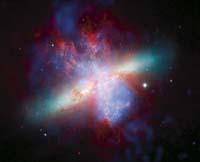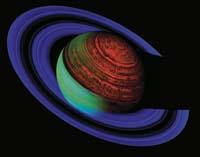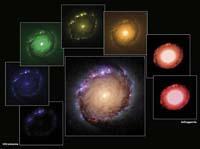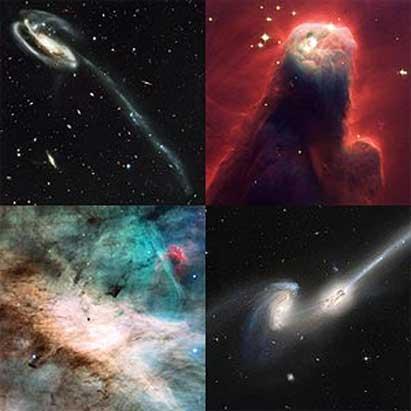The universe in color
2009/03/01 Etxebeste Aduriz, Egoitz - Elhuyar Zientzia Iturria: Elhuyar aldizkaria

Astronomers like to play with colors. The images obtained through the telescopes are manipulated and then show us stunning, elegant, colorful images. Sometimes they try, especially with the planets, to show them how we would really see them at first sight, but on other occasions the colors are absolutely false. In any case, there are almost always artificially colored images.
But the truth is that color is not a game. On the contrary, colors are a very valuable tool for astronomers. They help to see what we could not see otherwise, or to know more or less how we would see it if we were there.
Most of the information comes from the universe in the form of electromagnetic waves, which are the only ones capable of spreading to the void. Our eyes only detect some of these waves, which are part of the visible light, or the colors we know. But we also have more powerful eyes. The prestigious Hubble telescope sees many more "colors" than we do, including those we see. However, Hubble takes photos in black and white and then gives them by the astronomers painters.
Real color real color

To imitate what our eyes would see, they leave three photographs taken in black and white. These photos are usually filters, in this case with red, green and blue filter. Each filter lets pass only the corresponding color and what reflects the black and white photo is the amount of light or radiation emitted by a body determined for each color. Then, to obtain the color image, the color corresponding to each photo is given in black and white and the three overlap.
The images obtained are often labeled “real color” or “natural color”; the most sensible ones prefer “approximate real color”. It is similar to the process performed by a digital photo camera automatically. But Hubble has almost 40 filters and in addition to visible light it is capable of seeing ultraviolet and infrared, yes, always in black and white. Thus, Hubble can remove many more types of photos than a conventional photo camera. Depending on the filters used and the color given to each photo, the final result will be more or less close to reality.
That gives a lot of play. For example, and following the spectrum of visible light, among the gases of a nebula, oxygen atoms, hydrogen atoms, and nitrogen ions emit light at different wavelengths. Each element has its own exact wavelength, but in this case the three enter the red zone. We could not differentiate them: we would see everything red. But if we photograph with a filter for each of these specific wavelengths and then give a color to each of them, such as red to hydrogen, blue to oxygen and green to nitrogen, the image obtained will give us much more information.
Invisible to color

On the other hand, many of the messages sent to us by the universe reach us in wavelengths invisible to us. If we did not take into account, many astronomical bodies would not even know them, since the radiation emitted by them reaches Earth in the form of X-rays, infrared, ultraviolet, radio waves or microwave.
To know the secrets of the universe, it is essential to have eyes that see all these radiations. Near-infrared radiation, for example, is not extinguished as quickly as visible light, which allows to see areas shaded by interstellar dust, such as the denser parts of the nebulae and the centers of galaxies. In the 2MASS project they explored the sky with two telescopes that detect the near infrared: Between 1997 and 2001, one and a half million galaxies were detected, half of which were not previously cataloged.
The nearest galaxies are also visible in light, but if they are observed with other eyes, much more can be known about them. In ultraviolet light, stellar generation zones and young stars illuminate; in the infrared, interstellar dust and gas become visionaries; radio waves allow detecting molecules such as H 2, CO and NH 3; and if we heed X-rays, we can see the areas of greatest energy in the galaxy. Thus, the combination of all of them is fundamental to know what happens in a galaxy, how it evolves and what relationship it has with the medium.
Some of these radiations, such as the ultraviolet, the far infrared and the X-rays, do not reach the terrestrial surface. That is why it is essential that the eyes go out into space to see them. With the far infrared we can access totally opaque areas in the view. Most of the discoveries made in this wavelength were made at the end of the last century: The IRAS satellite found 350,000 new astronomical objects. On the other hand, since the year 2,003, in space there is another eye that sees in that wavelength: Spitzer telescope. With it, some of the most surprising images of recent years have been received.
Apart from sight, we cannot see the rest of the radiations, so the work of the painters astronomers is indispensable again. If we wanted to study a single wave, maybe it would be enough with the black and white image taken by the telescope, but our eyes see it in color in more detail than grayscale. To see several wavelengths at a glance, the help of colors is invaluable.

In the input photo, for example, you can see the galaxy M 82 at different wavelengths. In the view (yellow-green) you can see the disk of a spiral galaxy; the hot ionized gas that emits (orange) shows the existence of strong galactic winds, caused by the generation of stars in the center of the galaxy; in the far infrared (red), you can see that it emits in addition to gas, dust; and the gas that heats millions of degrees of collision between the material emits X-rays (blue).
Set of colors
Painters have the freedom to give the color they want to each wavelength. In general, the goal is to make contrast and visibility as big as possible, and in it the art of astronomers will surely have much to say. However, for some bodies often the same color code is used and if they are dressed in other colors, they become rare.
However, in these cases yes, the colors are absolutely false, pure invention. Therefore, the label of “false color” will be often seen in this type of photographs. But without that we could not see what the planets, nebulae and galaxies are made, or what their temperature is, etc.

Those who come in the name of the real color are also simple approximations. But what is the real color? The colors change continuously on Earth, if it is cloudy or clear, the sun more or less above, or in the atmosphere more or less dust… and all are real. As for photos, they will never be a 100% reflection of reality: each photo camera takes out the colors in its own way and if we see them on a screen the colors vary according to its configuration.
In the case of the universe, many colors are false and others just approximations. So if you want to know what reality is, you just have to go to the universe and look with your eyes.

Gai honi buruzko eduki gehiago
Elhuyarrek garatutako teknologia





